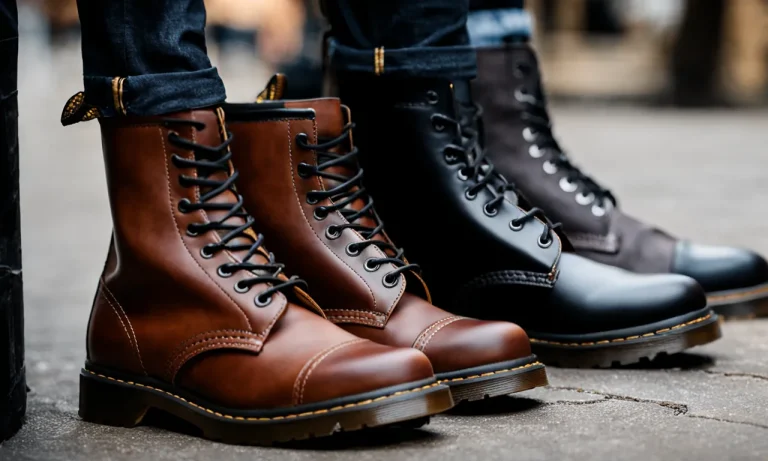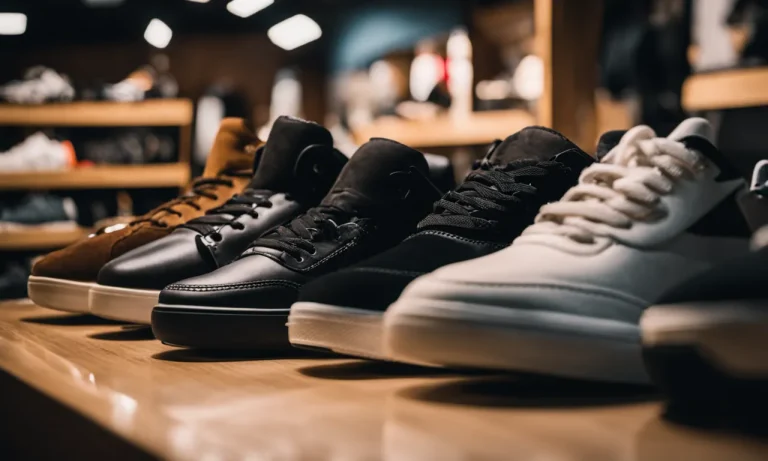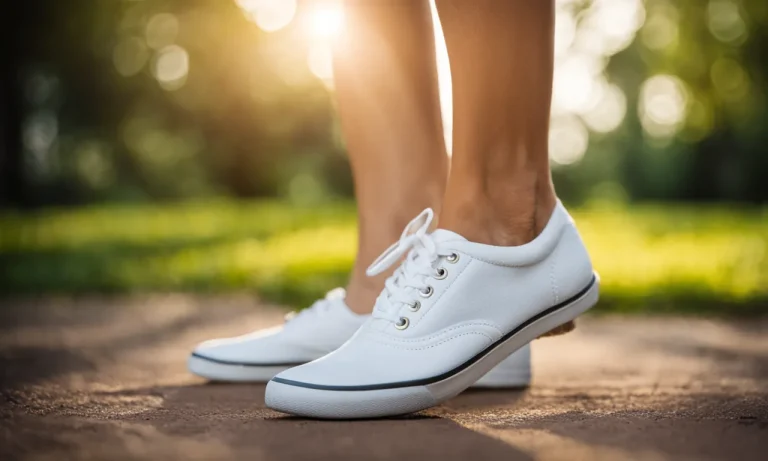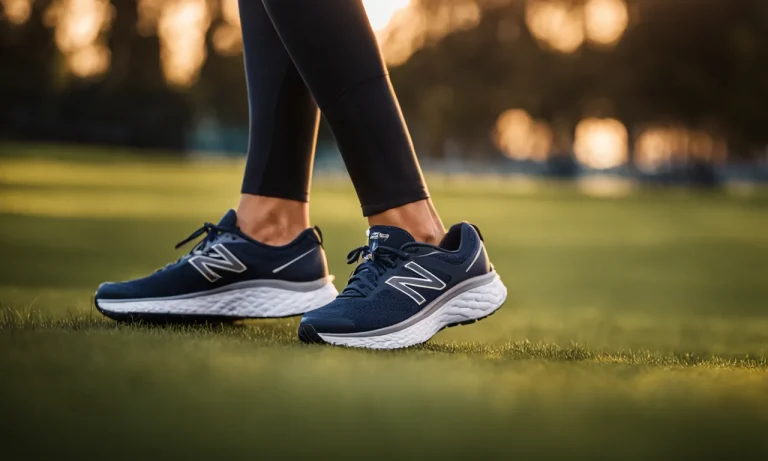Finding the perfect fitting shoe can be a frustrating endeavor. You try on pair after pair, debating whether to size up or size down. But does going up or down half a size really make that big of a difference?
If you’re short on time, here’s a quick answer: Going up or down half a size can make a noticeable difference in the fit and comfort of a shoe for most people. The slight change in length and width from sizing up or down half a size is often enough to take a shoe from uncomfortably tight to feeling just right.
In this comprehensive guide, we’ll explore whether half a shoe size truly makes a difference for your feet. We’ll look at key factors like foot dimensions, shoe construction, sock thickness, time of day, and foot conditions. We’ll also provide tips on how to determine your optimal shoe size.
How Your Foot Dimensions Change with Half Sizes
Length
When it comes to shoe sizes, length is one of the most important factors to consider. Your foot length determines the size of the shoe you need. However, what many people don’t realize is that half sizes can make a significant difference in the fit and comfort of a shoe.
For example, if you typically wear a size 8 shoe and try on a size 8.5, you may notice that there is slightly more room in the toe area, allowing for a more comfortable fit. On the other hand, if you try on a size 7.5, you may find that the shoe feels too tight and constricting.
Therefore, half sizes can give you the flexibility to find the perfect fit for your foot length.
Width
Foot width is another crucial aspect to consider when it comes to shoe sizing. Just like foot length, foot width can vary from person to person. Some individuals have narrow feet, while others have wider feet.
If you have a wider foot, opting for a half size up can make a significant difference in the comfort of your shoes. It allows for more room in the toe box and prevents unnecessary pressure on the sides of your feet.
On the other hand, if you have narrow feet, sticking to your exact size or even opting for a half size down can provide a snugger fit.
Volume
Foot volume refers to the overall thickness and height of your foot. This dimension can also vary among individuals. If you have a higher foot volume, meaning your foot is thicker or has a higher arch, half sizes can be a game-changer.
A shoe that is too tight can cause discomfort and restrict movement, while a shoe that is too loose can lead to instability and potential injuries. By choosing a half size that accommodates your foot volume, you can ensure a proper fit that provides the necessary support and comfort.
How Shoe Construction Impacts Fit
When it comes to finding the perfect fit for your feet, the construction of the shoe plays a crucial role. Every element, from the last shape to the uppers and insoles, can greatly affect how comfortable and supportive a shoe feels.
Let’s explore how these different aspects of shoe construction impact fit.
Last Shape
The last shape refers to the mold used to shape the shoe. It determines the overall shape, width, and volume of the shoe. Different shoe brands and models may have different last shapes, which can result in variations in fit.
For example, a shoe with a narrow last shape may not be suitable for individuals with wider feet. It’s important to consider the last shape when selecting shoes to ensure a proper fit.
Uppers
The uppers of a shoe are the material that covers the top part of the foot. They can be made of various materials, such as leather, synthetic fabrics, or mesh. The choice of uppers can affect the flexibility, breathability, and overall fit of the shoe.
For instance, leather uppers tend to provide more structure and durability, while mesh uppers offer better breathability. Understanding the different characteristics of uppers can help you choose a shoe that fits your needs and preferences.
Insoles
The insole is the inner part of the shoe that provides cushioning and support to the foot. It plays a vital role in determining the overall comfort of the shoe. Some shoes come with removable insoles, allowing you to customize the fit and support according to your preferences.
Additionally, insoles can also provide additional arch support or accommodate specific foot conditions, such as high arches or overpronation. Taking into account the type and quality of insoles can greatly impact the fit and comfort of a shoe.
It’s worth noting that while shoe construction has a significant impact on fit, individual foot characteristics also play a role. Factors such as foot width, arch height, and overall foot shape can influence how a shoe feels on your feet.
It’s always recommended to try on shoes and walk around in them to ensure a proper fit before making a purchase.
Other Factors That Influence Fit
Sock Thickness
When it comes to finding the right shoe size, the thickness of your socks can play a significant role. Thicker socks can take up more space inside the shoe, causing it to feel tighter. On the other hand, if you usually wear thin socks and try on shoes with thick socks, you may find that your usual size feels too loose.
It is important to consider the type of socks you typically wear and try on shoes with those socks to ensure the best fit.
Time of Day
Believe it or not, the time of day can affect the fit of your shoes. Our feet tend to swell throughout the day, especially if we spend a lot of time on our feet. Therefore, it is recommended to try on shoes later in the day when your feet are at their largest.
This will help you avoid buying shoes that feel too snug in the morning but become uncomfortably tight as the day goes on.
Foot Conditions
Individuals with certain foot conditions may need to consider additional factors when determining the right shoe size. For example, those with bunions may need to opt for wider shoes to accommodate the protrusion.
Similarly, people with high arches may require shoes with extra arch support to ensure proper comfort and fit. It is always a good idea to consult with a podiatrist or footwear specialist if you have any specific foot conditions that may affect your shoe size.
It is worth noting that these factors can vary from person to person, and what works for one individual may not work for another. It is important to take all of these factors into consideration when finding the right shoe size to ensure optimum comfort and fit.
Tips for Finding Your Perfect Shoe Size
Get Properly Measured
One of the most important tips for finding your perfect shoe size is to get properly measured. Many people underestimate the importance of a proper shoe fitting, but wearing the wrong size can lead to discomfort, foot problems, and even injuries.
Visit a reputable shoe store where a professional can measure your foot length and width accurately. Keep in mind that your shoe size may change over time, so it’s a good idea to get measured periodically.
Try Shoes On at Peak Foot Size
Did you know that your foot size can change throughout the day? Feet tend to swell and expand as the day goes on, especially after walking or standing for long periods. To ensure you find the perfect fit, try shoes on at your peak foot size.
This will give you a better idea of how the shoes will feel during everyday wear. If possible, try shoes on in the afternoon or evening when your feet are at their largest.
Consider Your Foot Type
Everyone’s feet are unique, and different shoe styles may fit differently depending on your foot type. Consider whether you have narrow or wide feet, high arches or flat feet, or any specific foot conditions.
Some shoe brands offer different width options, so it’s important to choose a shoe that accommodates your foot type. Additionally, certain shoe designs may be more suitable for specific foot shapes, providing better support and comfort.
Order Multiple Sizes
When shopping online, it can be challenging to determine the perfect shoe size without trying them on. To increase your chances of finding the right fit, consider ordering multiple sizes of the same shoe. This allows you to compare and try on different sizes in the comfort of your own home.
Keep in mind that different shoe brands may have slight variations in sizing, so it’s always a good idea to check the brand’s size chart for guidance.
Break Shoes In
Even if you find a shoe that fits perfectly, it’s important to remember that new shoes often require a break-in period. Leather shoes, in particular, may feel tight or uncomfortable initially, but they will gradually mold to the shape of your feet with regular wear.
To make the break-in process more comfortable, wear the shoes for short periods at first, gradually increasing the duration. You can also try using shoe stretchers or wearing thicker socks to help loosen up the material.
Finding your perfect shoe size is crucial for comfort and foot health. By following these tips and considering your unique foot characteristics, you can increase your chances of finding the right fit. Remember, a half a shoe size can make a significant difference in how a shoe fits, so don’t settle for anything less than your perfect fit!
Conclusion
Finding a well-fitting pair of shoes involves much more than simply going up or down half a size. Factors ranging from the dimensions of your feet to the shoes’ construction and materials all come into play.
While sizing in half increments can make a difference in fit for many wearers, focusing on other elements like shape and sock thickness may be just as important.
By learning your precise foot measurements, trying shoes on at the widest part of your foot, and selecting appropriate shoe shapes and constructions, you’re more likely to find footwear that fits and feels fantastic.
With some effort to determine your optimal size, half a shoe size difference can certainly make all the difference in comfort.






